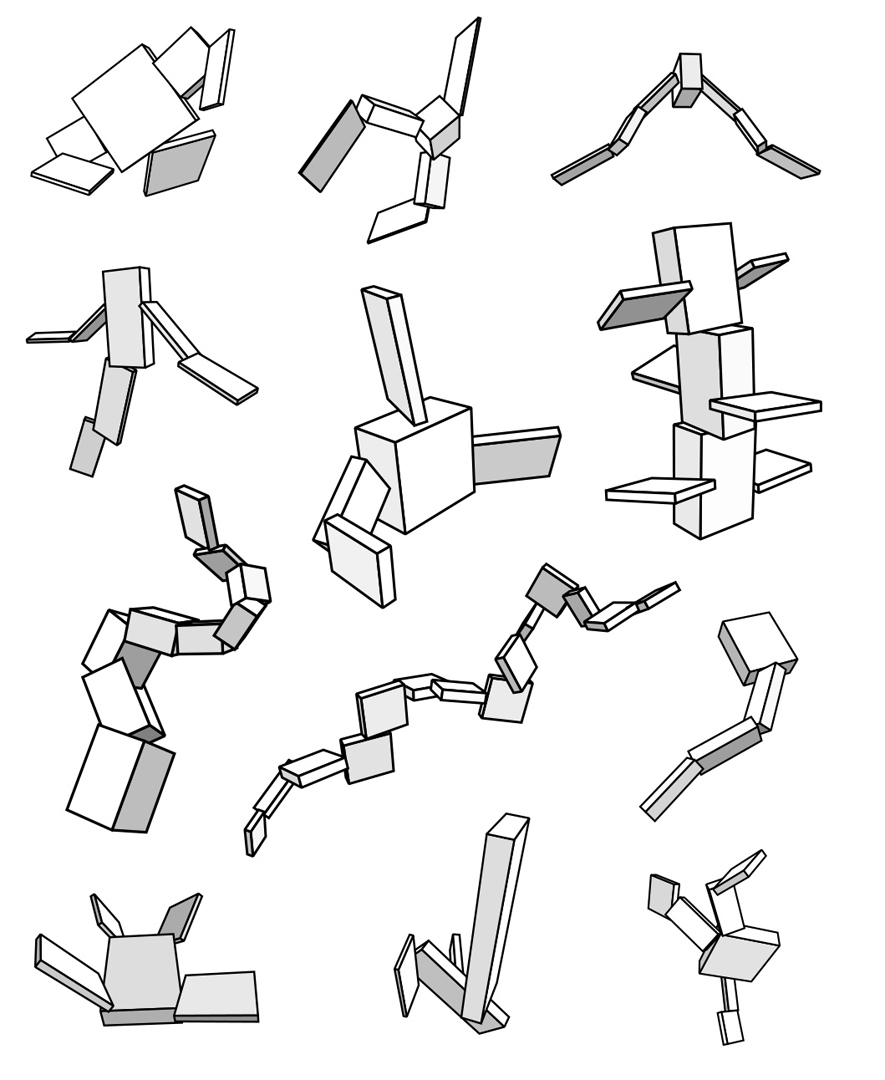“Evolving virtual creatures” by Sims
Conference:
Type(s):
Title:
- Evolving virtual creatures
Presenter(s)/Author(s):
Abstract:
This paper describes a novel system for creating virtual creatures that move and behave in simulated three-dimensional physical worlds. The morphologies of creatures and the neural systems for controlling their muscle forces are both generated automatically using genetic algorithms. Different fitness evaluation functions are used to direct simulated evolutions towards specific behaviors such as swimming, walking, jumping, and following.A genetic language is presented that uses nodes and connections as its primitive elements to represent directed graphs, which are used to describe both the morphology and the neural circuitry of these creatures. This genetic language defines a hyperspace containing an indefinite number of possible creatures with behaviors, and when it is searched using optimization techniques, a variety of successful and interesting locomotion strategies emerge, some of which would be difficult to invent or built by design.
References:
1. Cramer, N.L., “A Representation for the Adaptive Generation of Simple Sequential Programs,” Proceedings of the First International Conference on Genetic Algorithms, ed. by J. Grefenstette, 1985, pp.183-187.
2. Dawkins, R., The Blind Watchmaker, Harlow Longman, 1986.
3. Featherstone, R., Robot Dynamics Algorithms, Kluwer Aca-demic Publishers, Norwell, MA, 1987.
4. de Garis, H., “Genetic Programming: Building Artificial Ner-vous Systems Using Genetically Programmed Neural Network Modules,” Proceedings of the 7th International Conference on Machine Learning, 1990, pp.132-139.
5. Goldberg, D.E., Genetic Algorithms in Search, Optimization, and Machine Learning, Addison-Wesley, 1989.
6. Hart, J., “The Object Instancing Paradigm for Linear Fractal Modeling,” Graphics Interface, 1992, pp.224-231.
7. Holland, J.H., Adaptation in Natural and Artificial Systems, Ann Arbor, University of Michigan Press, 1975.
8. Kitano, H., “Designing neural networks using genetic algo-rithms with graph generation system,” Complex Systems, Vol.4, pp.461-476, 1990.
9. Koza, J., Genetic Programming: on the Programming of Com-puters by Means of Natural Selection, MIT Press, 1992.
10. Lindenmayer, A., “Mathematical Models for Cellular Interac-tions in Development, Parts I and II,” Journal of Theoretical Biology, Vol.18, 1968, pp.280-315.
11. McKenna, M., and Zeltzer, D., “Dynamic Simulation of Autonomous Legged Locomotion,” Computer Graphics, Vol.24, No.4, July 1990, pp.29-38.
12. Miller, G., “The Motion Dynamics of Snakes and Worms,” Computer Graphics, Vol.22, No.4, July 1988, pp.169-178.
13. Mjolsness, E., Sharp, D., and Alpert, B., “Scaling, Machine Learning, and Genetic Neural Nets,” Advances in Applied Mathematics, Vol.10, pp.137-163, 1989.
14. Ngo, J.T., and Marks, J., “Spacetime Constraints Revisited,” Computer Graphics, Annual Conference Series, 1993, pp.343- 350.
15. van de Panne, M., and Fiume, E., “Sensor-Actuator Net-works,” Computer Graphics, Annual Conference Series, 1993, pp.335-342.
16. Raibert, M., and Hodgins, J.K., “Animation of Dynamic Legged Locomotion,” Computer Graphics, Vol.25, No.4, July 1991, pp.349-358.
17. Ray, T., “An Approach to the Synthesis of Life,” Artificial Life II, ed. by Langton, Taylor, Farmer, & Rasmussen, Addison-Wesley, 1991, pp.371-408.
18. Sims, K., “Artificial Evolution for Computer Graphics,” Com-puter Graphics, Vol.25, No.4, July 1991, pp.319-328.
19. Sims, K., “Interactive Evolution of Dynamical Systems,” Toward a Practice of Autonomous Systems: Proceedings of the First European Conference on Artificial Life, ed. by Varela, Francisco, & Bourgine, MIT Press, 1992, pp.171-178.
20. Smith, A.R., “Plants, Fractals, and Formal Languages,” Com-puter Graphics, Vol.18, No.3, July 1984, pp.1-10.
21. Todd, S., and Latham, W., Evolutionary Art and Computers, London, Academic Press, 1992.
22. Yaeger, L., “Computational Genetics, Physiology, Metabo-lism, Neural Systems, Learning, Vision, and Behavior or Poly-World: Life in a New Context,” Artificial Life III, ed. by C. Langton, Santa Fe Institute Studies in the Sciences of Com-plexity, Proceedings Vol. XVII, Addison-Wesley, 1994, pp.263-298.




